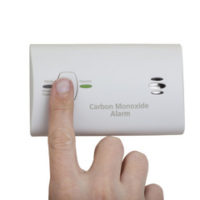Do Carbon Monoxide Detectors Have Expiration Dates?

You might think that your carbon monoxide (CO) alarm will go on forever so long as you replace the batteries as needed, but this is not so. In fact, most models have only a ten-year life span. Since 2009, standards for carbon monoxide alarms (UL 2034) have required the alarms to include warnings when they are approaching their end of useful life, although many models had this feature for years before then. Read on to learn more about the life span of CO alarms, and check to see that your home and family are adequately protected.
Carbon monoxide alarms are essential safety features of your home
There is no question that carbon monoxide alarms save lives, and that the danger of carbon monoxide poisoning in the home is very real. Solid statistics are not available regarding how many lives are saved each year by CO alarms, but it is not hard to find a story of a family whose lives were saved by an alarm that operated as it should. As to deaths caused by CO poisoning, statistics from the Centers for Disease Control and Prevention (CDC) totaled up 5,149 deaths from unintentional, non-fire-related carbon monoxide poisoning in the United States over a period from 1999 to 2010, an average of 430 deaths per year.
As discussed in a document produced by the Consumer Product Safety Commission (CPSC), carbon monoxide is a colorless, odorless gas produced when any fuel is incompletely burned, such as in-home fuel-burning heating equipment. Exposure to low levels of carbon monoxide (CO) over several hours can be just as dangerous as rapid exposure to high amounts. Symptoms of CO poisoning include dizziness, fatigue, headaches, nausea and irregular breathing. Confusion may set in before unconsciousness and eventually death, and without an alarm, people may not understand the nature of their symptoms before it is too late.
Why is my carbon monoxide alarm beeping?
A beeping smoke alarm means it’s time to change the battery. A beeping carbon monoxide alarm could mean it’s time to change the battery, but it could also mean it’s time to replace the entire device. It’s not always easy to know why the device is beeping, especially if you have a combination smoke detector and carbon monoxide alarm together in one device. If the unit continues to beep (or chirp) after you replace the battery, and you know the battery is good, then the product has probably come to the end of its useful life and should be replaced. Digital alarms may also display an error message, such as Err, an alphanumeric code you can look up in the product documentation, or End to clearly indicate it is time to replace the device.
Don’t wait to replace battery when you hear that annoying beeping or chirping. The unit could run out of power and stop beeping because it’s stopped working, and you’ll forget all about it, leaving you vulnerable to the silent attack of CO poisoning.
Home Heating Equipment and CO Alarms can Both be Defective
Since the presence of carbon monoxide in the home is otherwise undetectable, it can be impossible to know if your alarm is working properly, and it may not be. The CPSC recalls database includes a dozen different recalls of carbon monoxide alarms since 2006 from manufacturers including market leader Kidde, Honeywell, Google’s Nest and several others.
In 2016, a recall was initiated of the Kidde NightHawk talking combo smoke/CO alarm model number KN-COSM-IB with manufacture dates ranging from June 1, 2004 to December 31, 2010. This device is hard-wired into home’s electric power but also comes equipped with a 9v backup battery. The product was built with a seven-year life span but was considered defective because it may stop chirping when the batteries are replaced, even though it has reached its end of life and the alarm won’t function if needed. About 3.6 million affected units were sold in the U.S. before the recall, so you may want to make sure you don’t have this device in your home, which has passed its useful life by now regardless of the defect due to age.
More recently, Kidde recalled its Dual Sensor smoke alarm models PI2010 and PI9010 in March 21, 2018. These products were released on the market with a yellow protective cap covering a sensor, which limits its ability to detect smoke. Nearly half a million units have been sold in the U.S. You should be able to visibly detect whether you have a unit with a yellow cap. If so, don’t try to remove the cap yourself. Instead, contact Kidde for a replacement.
In addition to defective carbon monoxide alarm recalls, the CPSC database includes pages and pages of recalls of boilers and water heaters recalled for risk of carbon monoxide poisoning. The fact that so many defective home heating units are out there pumping carbon monoxide into the home presents a very real danger and immediate need for working carbon monoxide alarms. A search of the CPSC recalls database for “monoxide” can help to turn up recalls for both defective alarms as well as defective products such as heaters which may be emitting carbon monoxide into the home. It’s also a good idea to register any consumer product you purchase so you can be contacted by the manufacturer or applicable government agency in the event of a recall.



